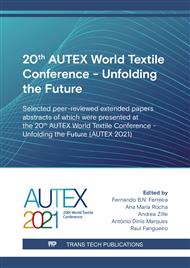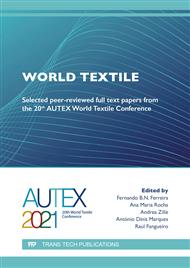[1]
R.W.G. Hunt, M.R. Pointer, Measuring colour, fourth ed., Wiley, Chichester, (2011).
Google Scholar
[2]
W.J. Benjamin, Borish's Clinical Refraction, second ed., Butterworth-Heinemann/Elsevier, St. Louis, (2006).
Google Scholar
[3]
A. Stockman, L.T. Sharpe, C. Fach, The spectral sensitivity of the human short-wavelength sensitive cones derived from thresholds and color matches, Vision Research 39(17) (1999) 2901-2927.
DOI: 10.1016/s0042-6989(98)00225-9
Google Scholar
[4]
A. Stockman, L.T. Sharpe, The spectral sensitivities of the human middle- and long-wavelength-sensitive cones derived from measurements in observers of known genotype, Vision Research 40(13) (2000) 1711-1737.
DOI: 10.1016/s0042-6989(00)00021-3
Google Scholar
[5]
M. Vik, M. Viková, M. Pechová, Color discrimination on the border of photopic/mesopic vision, in: FEKT VUT, Proceedings of the 21st International Conference LIGHT SVĚTLO 2015, FEKT VUT, Brno, 2015, pp.97-100.
DOI: 10.13164/conf.light.2015.97
Google Scholar
[6]
M. Pechová, M. Kašparová, M. Vik M. Viková, J. Štefl, Influence of luminance levels of illumination D65 on evaluation of high chromatic colour, in: Proceedings of the 4th CIE expert symposium on colour and visual appearance, Commission Internationale de L'Eclairage, Vienna, 2016, pp.269-277.
Google Scholar
[7]
A. Stockman, M. Langendörfer, H.E. Smithson, L.T. Sharpe, Human cone light adaptation: From behavioral measurements to molecular mechanisms, Journal of Vision 6(11) (2006) 1194-1203.
DOI: 10.1167/6.11.5
Google Scholar
[8]
M.R. Luo, Ch. Li, CIE Color Appearance Models and Associated Color Spaces, in: J. Schanda (Eds.), Colorimetry: Understanding the CIE System, Wiley, Chichester, 2011, pp.255-299.
DOI: 10.1002/9780470175637.ch11
Google Scholar
[9]
Stuart Anstis, The Purkinje rod-cone shift as a function of luminance and retinal eccentricity, Vision Research 42(22) (2002) 2845-2491.
DOI: 10.1016/s0042-6989(02)00267-5
Google Scholar
[10]
U. Wolfe, N. Ali, Dark Adaptation and Purkinje Shift: A Laboratory Exercise in Perceptual Neuroscience, The Journal of Undergraduate Neuroscience Education 13(2) (2015) A59-A63.
Google Scholar
[11]
M.R. Luo, Ch. Li, CIECAM02 and Its Recent Developments, in: C. Fernandez-Maloigne, Advanced Color Image Processing and Analysis, Springer, New York, 2013, pp.19-58.
DOI: 10.1007/978-1-4419-6190-7_2
Google Scholar
[12]
R.-C. Wu, R.H. Wardman, Proposed modification to the CIECAM02 colour appearance model to include the simultaneous contrast effects, Color Research & Application 32(2) (2007) 121-129.
DOI: 10.1002/col.20297
Google Scholar
[13]
M.R. Luo, G. Cui, Ch. Li, Uniform colour spaces based on CIECAM02 colour appearance model, Color Research & Application 31(4) (2006) 320-330.
DOI: 10.1002/col.20227
Google Scholar
[14]
Ch. Li, Z. Li, Z. Wang, Y. Xu, M.R. Luo, G. Cui et al., Comprehensive color solutions: CAM16, CAT16 a CAM16-UCS, Color Research & Application 42(6) (2017) 703-718.
DOI: 10.1002/col.22131
Google Scholar
[15]
Z. Wang, C. Gao, Y. Xu, M. Melgosa et al., Further investigation on the modified hyperbolic function in the CAM16 color appearance model, Color Research & Application 44(3) (2019) 359-366.
DOI: 10.1002/col.22347
Google Scholar
[16]
J. Jiang, Z. Wang, M.R. Luo, M. Melgosa, M.H. Brill, C. Li, Optimum solution of the CIECAM02 yellow-blue and purple problems, Color Research & Application 40(5) (2014) 491-503.
DOI: 10.1002/col.21921
Google Scholar
[17]
Ch. Li, Z. Li, Z. Wang, Y. Xu, M.R. Luo., G. Cui, M. Melgosa, M. Pointer, A revision of CIECAM02 and its CAT and UCS, in: Color and Imaging Conference, Society for Imaging Science and Technology, 2016, pp.208-212(5).
DOI: 10.2352/issn.2169-2629.2017.32.208
Google Scholar
[18]
M. Kašparová, M. Pechová, M. Viková, M. Vik, J. Štefl, Visual evaluation samples with high chromaticity under the two types of daylight simulators, in: Proceedings of the 4th CIE expert symposium on colour and visual appearance, Commission Internationale de L'Eclairage, Vienna, 2016, pp.278-286.
Google Scholar
[19]
M. Pechová, M. Viková, M. Vik, The effect of luminance level on color difference evaluation, in: FEKT VUT, Proceedings of the 23rd International Conference Light - Světlo 2019, VŠB-TUO, Ostrava, 2019, pp.55-58.
Google Scholar
[20]
M. Vik, M. Viková, M. Kašparová, Color difference evaluation at high chromatic colors, Fibres and textiles (Vlákna a textil) 1 (2015) 68-74.
Google Scholar
[21]
M. Melgosa, P.A. García, L. Gómez-Robledo, R. Shamey et al., Notes on the application of the standardized residual sum of squares index for the assessment of intra- and inter-observer variability in color-difference experiments, JOSA A 28(5) (2011) 949-953.
DOI: 10.1364/josaa.28.000949
Google Scholar



